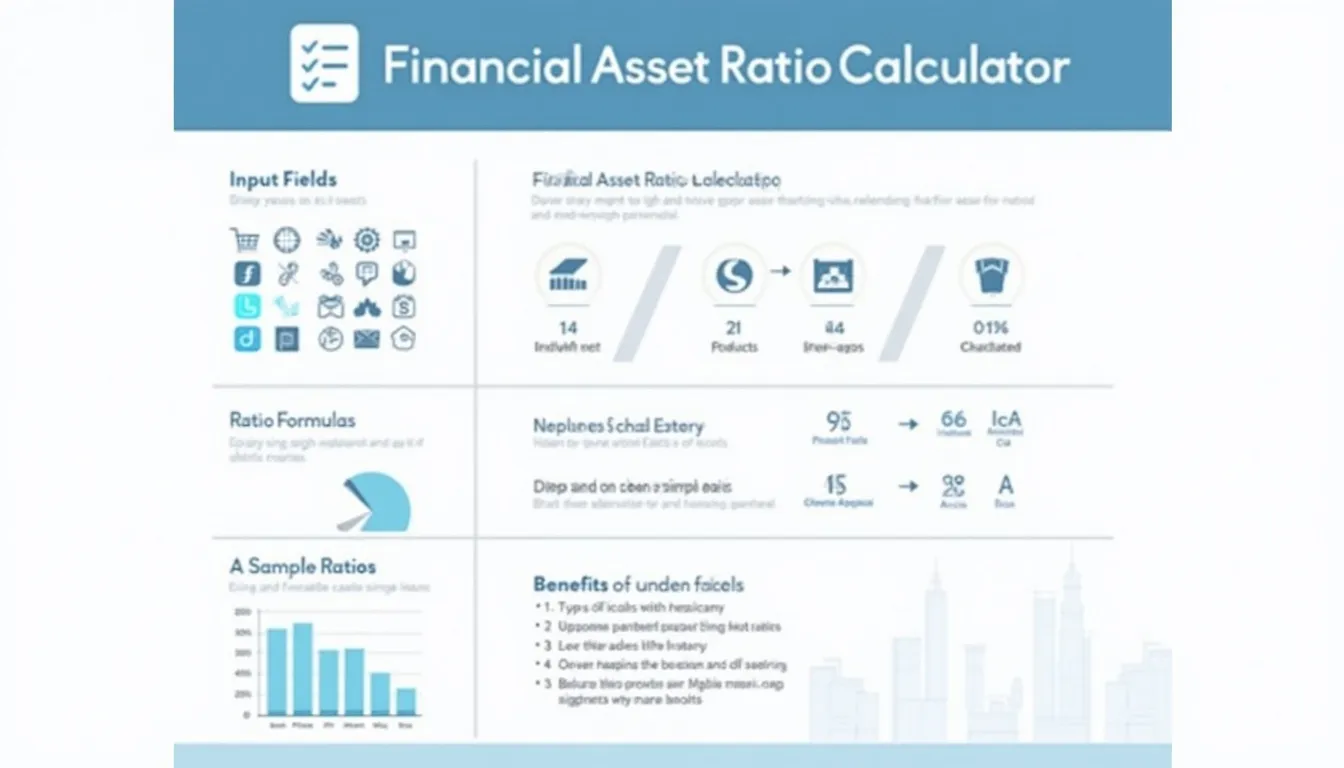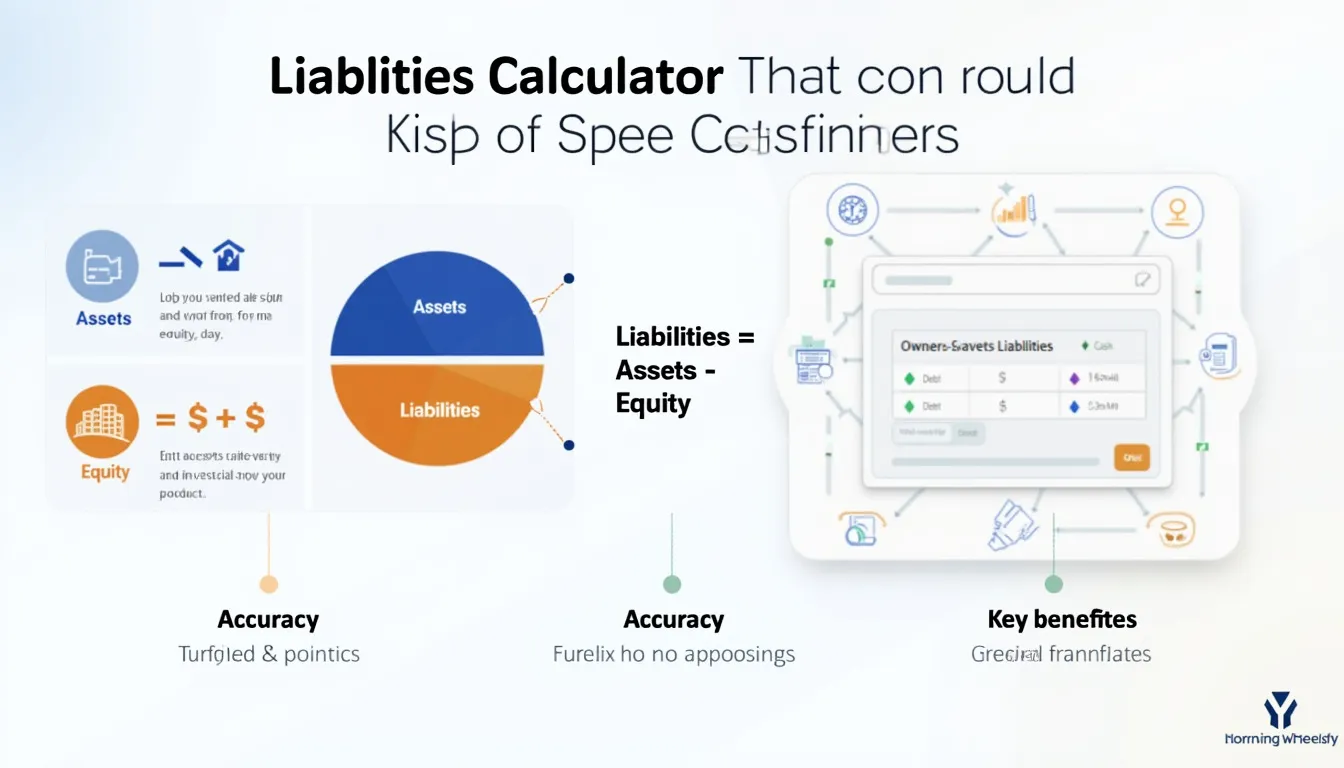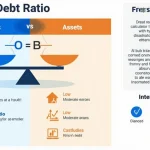Financial Asset Ratio Calculator
Is this tool helpful?
Welcome to our comprehensive guide on the Financial Asset Ratio Calculator, a powerful tool designed to help you analyze and understand the financial health of a company. Whether you’re an investor, financial analyst, or business owner, this calculator will provide you with valuable insights into a company’s financial performance and stability.
How to Use the Financial Asset Ratio Calculator Effectively
Our user-friendly Financial Asset Ratio Calculator is designed to simplify the process of calculating key financial ratios. Here’s a step-by-step guide on how to use it effectively:
- Gather financial data: Collect the necessary financial information from the company’s balance sheet and income statement.
- Input the values: Enter the required financial data into the corresponding fields of the calculator.
- Review the results: After entering all the required information, click the “Calculate Ratios” button to generate the financial ratios.
- Analyze the ratios: Examine the calculated ratios to gain insights into the company’s financial health and performance.
Understanding Financial Asset Ratios: Definition, Purpose, and Benefits
Financial asset ratios are essential tools used to evaluate a company’s financial performance, efficiency, and overall health. These ratios provide valuable insights into various aspects of a company’s operations, including liquidity, solvency, profitability, and efficiency.
The primary purpose of calculating financial asset ratios is to:
- Assess a company’s financial stability and performance
- Compare a company’s financial metrics with industry benchmarks
- Identify potential areas of improvement in financial management
- Make informed investment decisions
- Evaluate a company’s ability to meet its financial obligations
By using our Financial Asset Ratio Calculator, you can quickly and accurately compute these crucial ratios, saving time and reducing the risk of calculation errors.
Benefits of Using the Financial Asset Ratio Calculator
Our Financial Asset Ratio Calculator offers numerous benefits to users across various financial disciplines:
1. Time-saving and Efficient
Manual calculations of financial ratios can be time-consuming and prone to errors. Our calculator automates this process, allowing you to obtain accurate results in seconds.
2. Comprehensive Analysis
The calculator provides a wide range of financial ratios, offering a holistic view of a company’s financial health. This comprehensive approach enables users to make well-informed decisions based on multiple financial aspects.
3. Accuracy and Consistency
By eliminating human error in calculations, our tool ensures consistent and accurate results every time you use it. This reliability is crucial for making sound financial decisions.
4. User-friendly Interface
The intuitive design of our calculator makes it accessible to users with varying levels of financial expertise. Whether you’re a seasoned financial analyst or a business student, you’ll find the tool easy to navigate and use.
5. Instant Results
With just a few clicks, you can obtain a complete set of financial ratios. This instant feedback allows for quick decision-making and efficient financial analysis.
6. Facilitates Comparative Analysis
By providing a standardized method of calculating financial ratios, our tool enables easy comparison of financial performance across different companies or time periods.
Addressing User Needs: How the Financial Asset Ratio Calculator Solves Specific Problems
Our Financial Asset Ratio Calculator addresses several key challenges faced by financial professionals, investors, and business owners:
1. Simplifying Complex Calculations
Financial ratio calculations can be complex, especially when dealing with multiple variables. Our calculator simplifies this process, making it accessible to users of all skill levels.
2. Providing Quick Financial Insights
In the fast-paced world of finance, quick decision-making is crucial. Our calculator delivers instant results, allowing users to gain rapid insights into a company’s financial health.
3. Enhancing Financial Literacy
By presenting a comprehensive set of financial ratios, our tool helps users understand various aspects of financial analysis, contributing to improved financial literacy.
4. Facilitating Investment Decisions
Investors can use the calculator to quickly assess the financial health of potential investment opportunities, aiding in more informed decision-making.
5. Supporting Business Management
Business owners and managers can utilize the tool to monitor their company’s financial performance and identify areas for improvement.
Understanding the Financial Ratios: Formulas and Interpretations
Let’s delve into the financial ratios calculated by our tool and understand their significance:
1. Current Ratio
The current ratio measures a company’s ability to pay its short-term obligations.
$$ \text{Current Ratio} = \frac{\text{Current Assets}}{\text{Current Liabilities}} $$A ratio greater than 1 indicates that the company has sufficient current assets to cover its current liabilities.
2. Debt to Equity Ratio
This ratio assesses a company’s financial leverage by comparing total debt to shareholders’ equity.
$$ \text{Debt to Equity Ratio} = \frac{\text{Total Debt}}{\text{Total Equity}} $$A lower ratio suggests less reliance on debt financing, which is generally considered less risky.
3. Return on Assets (ROA)
ROA measures how efficiently a company uses its assets to generate profits.
$$ \text{Return on Assets} = \frac{\text{Net Income}}{\text{Total Assets}} $$A higher ROA indicates better asset utilization and profitability.
4. Return on Equity (ROE)
ROE measures the profitability of a company in relation to shareholders’ equity.
$$ \text{Return on Equity} = \frac{\text{Net Income}}{\text{Total Equity}} $$A higher ROE suggests better efficiency in utilizing shareholders’ investments to generate profits.
5. Asset Turnover Ratio
This ratio measures how efficiently a company uses its assets to generate revenue.
$$ \text{Asset Turnover Ratio} = \frac{\text{Total Revenue}}{\text{Total Assets}} $$A higher ratio indicates more efficient use of assets in generating sales.
6. Profit Margin
The profit margin shows the percentage of revenue that translates into profit.
$$ \text{Profit Margin} = \frac{\text{Net Income}}{\text{Total Revenue}} $$A higher profit margin indicates better profitability and cost management.
Practical Applications: Examples and Use Cases
To illustrate the practical applications of our Financial Asset Ratio Calculator, let’s consider a few examples:
Example 1: Assessing Company Liquidity
Suppose you’re analyzing a retail company with the following financial data:
- Current Assets: $500,000
- Current Liabilities: $300,000
Using our calculator, you’d find that the Current Ratio is 1.67 (500,000 / 300,000). This indicates that the company has $1.67 in current assets for every $1 of current liabilities, suggesting good short-term liquidity.
Example 2: Evaluating Financial Leverage
Consider a manufacturing company with the following data:
- Total Debt: $2,000,000
- Total Equity: $4,000,000
The Debt to Equity Ratio calculated would be 0.5 (2,000,000 / 4,000,000). This suggests that the company has $0.50 of debt for every $1 of equity, indicating a relatively low level of financial leverage.
Example 3: Analyzing Profitability
Let’s examine a technology company with these financials:
- Net Income: $1,000,000
- Total Assets: $10,000,000
- Total Equity: $8,000,000
Using our calculator, you’d find:
- Return on Assets (ROA): 10% (1,000,000 / 10,000,000)
- Return on Equity (ROE): 12.5% (1,000,000 / 8,000,000)
These ratios indicate that the company is generating a 10% return on its assets and a 12.5% return on shareholders’ equity, which could be compared to industry benchmarks to assess performance.
Frequently Asked Questions (FAQ)
1. What financial statements do I need to use the Financial Asset Ratio Calculator?
You’ll need information from the company’s balance sheet and income statement. These statements provide the necessary data for calculating the various financial ratios.
2. How often should I calculate these financial ratios?
It’s generally recommended to calculate these ratios quarterly or annually, coinciding with the release of financial statements. However, more frequent calculations can be beneficial for closer monitoring of financial performance.
3. Can I use this calculator for any type of business?
Yes, our Financial Asset Ratio Calculator can be used for various types of businesses. However, it’s important to note that the interpretation of these ratios may vary depending on the industry and specific business model.
4. Are there industry-specific benchmarks for these ratios?
Yes, many industries have specific benchmarks for financial ratios. It’s advisable to compare a company’s ratios not only to its past performance but also to industry averages for a more comprehensive analysis.
5. What if I get negative results for some ratios?
Negative ratios can occur, particularly for profitability ratios if a company is experiencing losses. These results warrant careful analysis and may indicate financial difficulties.
6. How do I interpret changes in these ratios over time?
Changes in ratios over time can indicate trends in a company’s financial performance. Improving ratios generally suggest better financial health, while declining ratios may indicate areas of concern.
7. Can this calculator be used for personal finance?
While primarily designed for business financial analysis, some of these ratios (like the debt-to-equity ratio) can be adapted for personal finance analysis. However, interpretation may differ in a personal finance context.
8. How accurate is this Financial Asset Ratio Calculator?
Our calculator uses standard financial formulas to compute ratios. However, the accuracy of the results depends on the accuracy of the input data. Always double-check your inputs for the most reliable results.
Please note that while we strive for accuracy, we cannot guarantee that the results from our webtool are always correct, complete, or reliable. Our content and tools might have mistakes, biases, or inconsistencies. Always consult with a qualified financial professional for important financial decisions.
Conclusion: Empowering Financial Decision-Making
The Financial Asset Ratio Calculator is an invaluable tool for anyone involved in financial analysis, investment decision-making, or business management. By providing quick, accurate calculations of key financial ratios, it empowers users to:
- Gain deeper insights into a company’s financial health
- Make more informed investment decisions
- Identify areas for financial improvement in business operations
- Compare financial performance across different companies or time periods
- Enhance overall financial literacy and analytical skills
We encourage you to leverage the power of our Financial Asset Ratio Calculator in your financial analysis endeavors. Whether you’re evaluating potential investments, assessing your company’s financial performance, or simply expanding your financial knowledge, this tool will prove to be an indispensable asset in your financial toolkit.
Start using our Financial Asset Ratio Calculator today and unlock new levels of financial insight and decision-making power!
Important Disclaimer
The calculations, results, and content provided by our tools are not guaranteed to be accurate, complete, or reliable. Users are responsible for verifying and interpreting the results. Our content and tools may contain errors, biases, or inconsistencies. We reserve the right to save inputs and outputs from our tools for the purposes of error debugging, bias identification, and performance improvement. External companies providing AI models used in our tools may also save and process data in accordance with their own policies. By using our tools, you consent to this data collection and processing. We reserve the right to limit the usage of our tools based on current usability factors. By using our tools, you acknowledge that you have read, understood, and agreed to this disclaimer. You accept the inherent risks and limitations associated with the use of our tools and services.







